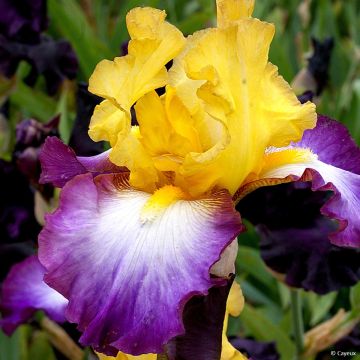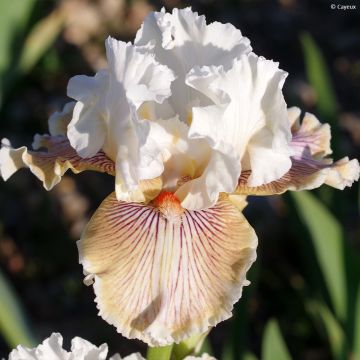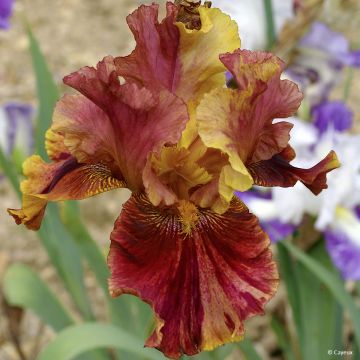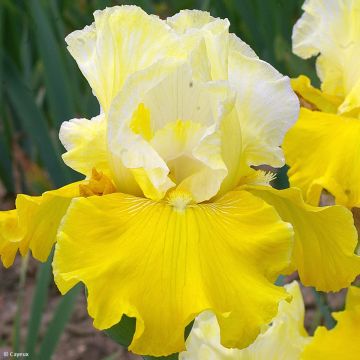

Iris germanica Anaconda Love - Bearded Iris
Iris germanica Anaconda Love - Bearded Iris
Iris germanica Anaconda Love
German Iris, Bearded Iris
Took some time to establish but bloomed in the first year, thrives well in my south-facing planter, beautiful flowers.
Tatiana, 03/03/2023
Special offer!
Receive a €20 voucher for any order over €90 (excluding delivery costs, credit notes, and plastic-free options)!
1- Add your favorite plants to your cart.
2- Once you have reached €90, confirm your order (you can even choose the delivery date!).
3- As soon as your order is shipped, you will receive an email containing your voucher code, valid for 3 months (90 days).
Your voucher is unique and can only be used once, for any order with a minimum value of €20, excluding delivery costs.
Can be combined with other current offers, non-divisible and non-refundable.
Why not try an alternative variety in stock?
View all →This plant carries a 12 months recovery warranty
More information
We guarantee the quality of our plants for a full growing cycle, and will replace at our expense any plant that fails to recover under normal climatic and planting conditions.

Would this plant suit my garden?
Set up your Plantfit profile →
Description
Iris germanica 'Anaconda Love' is part of the border iris, shorter than the Tall Bearded Iris, but flowering at the same time, in May-June. It also belongs to the category of "broken colours," whose striped and curiously variegated flowers are perfectly original. This one has beautifully undulated corollas made of pink petals veined with light purple and sepals variegated with beetroot red and silver-white, each flower being unique. Vigorous, it quickly forms beautiful clumps and its slightly scented flowers are as beautiful in the garden as they are in bouquets. It is an excellent variety, awarded several times.
The 'Anaconda Love' Iris is a perennial rhizomatous plant that develops from spring in elegantly upright clumps, with foliage disappearing in winter. It belongs to the Iridaceae family. It is one of the many cultivars obtained over the centuries, whose controversial origin is discussed around the number of chromosomes of potential ancestors. It should be noted that Garden Irises have European origins. They are plants that thrive in calcareous soils and require plenty of sunlight for their rhizomes to "cook" in summer in order to flower. A minimum of 6 hours of sunlight per day is generally required.
'Anaconda Love' will reach a height of 60cm (24in) when in bloom, with several buds per stem. The clump will spread indefinitely over time, with the centre rhizomes giving way to the outer ones. The foliage consists of long, wide, sword-shaped leaves, a slightly glaucous green, with parallel veins. In April-May, floral stems appear that will produce flowers blooming from the top to the lower branches in May-June. The surprising colour of this plant is, as always with Garden Irises, magnified by the thick, iridescent texture of the upright petals and the trailing sepals. At the base of each sepal sits a pretty velvety orange beard.
Obtained by Brad Kasparek, 1999.
Awards: HM (Honorable Mention) in 2001, AM (Award of Merit) in 2003, and Knowlton Medal in 2006.
To accompany irises, choose plants to associate with them based on their needs (exposure, soil...) their "respectful" vegetation towards irises (low-growing or light foliage plants), and their decorative complementarity (appearance, flowering date). For example, Gaura will provide little shade to the irises and will keep the deflowered iris bed attractive throughout the summer. Eschscholzia will be satisfied with a dry soil in summer, just like the irises. Geraniums, salvias, and Libertia also go very well with irises. Slopes and terraced edges will be stabilized by a dense planting of old diploid varieties that can remain in place and require little care. If the goal is more decorative and access for maintenance is possible, you can choose more modern varieties, for example, intermediates that are less likely than tall ones to be literally knocked to the ground by wind and rain.
At the base of a wall, the relative shelter from the wind allows for the use of tall irises. Of course, you can also plant shorter and earlier varieties in the foreground.
Path border: the realm of early dwarf irises less than 40cm (16in) tall, up to intermediates (in size and earliness) and border irises, medium-sized but flowering with the tall ones.
Mass planting border: the domain of border irises but also dwarfs, depending on the circumstances.
Mixed-border: the entire range of sizes can be used, to be chosen according to the space (foreground, background) and the size of the surrounding plants.
Iris bed, iris garden: the paradise of the iris lover where the choice of varieties (shape, colour, fragrance...) reflects each person's taste. The use of the full range of bearded irises allows for two and a half months of flowers in spring. The choice of so-called re-blooming irises offers some additional flowers in late summer or autumn, depending on the climate.
The vegetable garden can be adorned with a few clumps or borders of irises because it is also the classic place for the family cultivation of cut flowers.
Report an error about the product description
Iris germanica Anaconda Love - Bearded Iris in pictures




Flowering
Foliage
Plant habit
Botanical data
Iris
germanica
Anaconda Love
Iridaceae
German Iris, Bearded Iris
Cultivar or hybrid
Other German Iris - Bearded Iris
View all →Planting and care
Iris germanica should be planted in late summer, in August-September, when the rootstocks are at rest. They require a well-drained, calcareous and well-tilled soil that does not retain too much water. Allow for an appropriate spacing based on the size and vigour of the variety: about 34-50cm (13-20in) for tall varieties (5 to 10 plants per square metre). Dig a hole that is wide and deep enough. Create a conical mound of soil in the hole, on which the rootstock and spread-out roots are placed. Cover the roots. It is important for the rootstock to be slightly exposed above the surface of the soil. It should not be planted in a depression (risk of rot), so anticipate that the soil will settle and the iris will sink. In clayey or wet soil, the rootstock can even be raised on a slight mound of a few centimetres. To make the soil adhere to the roots, lightly compact the soil and water it abundantly after planting. Water 2-3 times if necessary until the plant takes root. For a mix of colours, it is aesthetically recommended to plant irises in groups of several plants of the same variety. Always consider the direction of growth of the rootstocks by arranging them in a star shape, with buds and leaves facing outward, and ensure they are well spaced from other varieties to allow for proper development.
As soon as the flower stalks appear, watch out for attacks from gastropods, which can completely destroy a flower stalk overnight by cutting it off.
Planting period
Intended location
Care
-
, onOrder confirmed
Reply from on Promesse de fleurs
Similar products
Haven't found what you were looking for?
Hardiness is the lowest winter temperature a plant can endure without suffering serious damage or even dying. However, hardiness is affected by location (a sheltered area, such as a patio), protection (winter cover) and soil type (hardiness is improved by well-drained soil).

Photo Sharing Terms & Conditions
In order to encourage gardeners to interact and share their experiences, Promesse de fleurs offers various media enabling content to be uploaded onto its Site - in particular via the ‘Photo sharing’ module.
The User agrees to refrain from:
- Posting any content that is illegal, prejudicial, insulting, racist, inciteful to hatred, revisionist, contrary to public decency, that infringes on privacy or on the privacy rights of third parties, in particular the publicity rights of persons and goods, intellectual property rights, or the right to privacy.
- Submitting content on behalf of a third party;
- Impersonate the identity of a third party and/or publish any personal information about a third party;
In general, the User undertakes to refrain from any unethical behaviour.
All Content (in particular text, comments, files, images, photos, videos, creative works, etc.), which may be subject to property or intellectual property rights, image or other private rights, shall remain the property of the User, subject to the limited rights granted by the terms of the licence granted by Promesse de fleurs as stated below. Users are at liberty to publish or not to publish such Content on the Site, notably via the ‘Photo Sharing’ facility, and accept that this Content shall be made public and freely accessible, notably on the Internet.
Users further acknowledge, undertake to have ,and guarantee that they hold all necessary rights and permissions to publish such material on the Site, in particular with regard to the legislation in force pertaining to any privacy, property, intellectual property, image, or contractual rights, or rights of any other nature. By publishing such Content on the Site, Users acknowledge accepting full liability as publishers of the Content within the meaning of the law, and grant Promesse de fleurs, free of charge, an inclusive, worldwide licence for the said Content for the entire duration of its publication, including all reproduction, representation, up/downloading, displaying, performing, transmission, and storage rights.
Users also grant permission for their name to be linked to the Content and accept that this link may not always be made available.
By engaging in posting material, Users consent to their Content becoming automatically accessible on the Internet, in particular on other sites and/or blogs and/or web pages of the Promesse de fleurs site, including in particular social pages and the Promesse de fleurs catalogue.
Users may secure the removal of entrusted content free of charge by issuing a simple request via our contact form.
The flowering period indicated on our website applies to countries and regions located in USDA zone 8 (France, the United Kingdom, Ireland, the Netherlands, etc.)
It will vary according to where you live:
- In zones 9 to 10 (Italy, Spain, Greece, etc.), flowering will occur about 2 to 4 weeks earlier.
- In zones 6 to 7 (Germany, Poland, Slovenia, and lower mountainous regions), flowering will be delayed by 2 to 3 weeks.
- In zone 5 (Central Europe, Scandinavia), blooming will be delayed by 3 to 5 weeks.
In temperate climates, pruning of spring-flowering shrubs (forsythia, spireas, etc.) should be done just after flowering.
Pruning of summer-flowering shrubs (Indian Lilac, Perovskia, etc.) can be done in winter or spring.
In cold regions as well as with frost-sensitive plants, avoid pruning too early when severe frosts may still occur.
The planting period indicated on our website applies to countries and regions located in USDA zone 8 (France, United Kingdom, Ireland, Netherlands).
It will vary according to where you live:
- In Mediterranean zones (Marseille, Madrid, Milan, etc.), autumn and winter are the best planting periods.
- In continental zones (Strasbourg, Munich, Vienna, etc.), delay planting by 2 to 3 weeks in spring and bring it forward by 2 to 4 weeks in autumn.
- In mountainous regions (the Alps, Pyrenees, Carpathians, etc.), it is best to plant in late spring (May-June) or late summer (August-September).
The harvesting period indicated on our website applies to countries and regions in USDA zone 8 (France, England, Ireland, the Netherlands).
In colder areas (Scandinavia, Poland, Austria...) fruit and vegetable harvests are likely to be delayed by 3-4 weeks.
In warmer areas (Italy, Spain, Greece, etc.), harvesting will probably take place earlier, depending on weather conditions.
The sowing periods indicated on our website apply to countries and regions within USDA Zone 8 (France, UK, Ireland, Netherlands).
In colder areas (Scandinavia, Poland, Austria...), delay any outdoor sowing by 3-4 weeks, or sow under glass.
In warmer climes (Italy, Spain, Greece, etc.), bring outdoor sowing forward by a few weeks.



























































